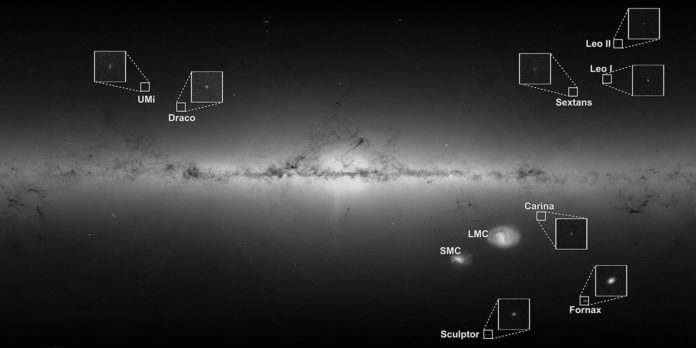For decades, dwarf galaxies surrounding Milky Way have been thought to be satellites. They have been considered a constant companion of our galaxy for billions of years.
Data from ESA’s Gaia mission is re-writing the history of our galaxy, the Milky Way. The data has computed the motions of these dwarf galaxies with unprecedented precision, and results are surprising.
Using data from Gaia, scientists calculated the movements of 40 dwarf galaxies around the Milky Way. They did this by three-dimensional computing velocities for each galaxy. Using that data, they calculated the galaxy’s orbital energy and the angular (rotational) momentum.
They found that these galaxies are moving much faster than the giant stars, and star clusters are known to be orbiting the Milky Way. So fast that they couldn’t be in orbit yet around the Milky Way, where interactions with our galaxy and its contents would have sapped their orbital energy and angular momentum.
In the case of the dwarf galaxies in the new study, which represents the majority of the dwarf galaxies around the Milky Way, their energies are still higher. This strongly suggests that they have only arrived in our vicinity in the last few billion years.
The discovery mirrors one made about the Large Magellanic Cloud (LMC). The LMC was also thought to be a satellite galaxy of the Milky Way. When measuring its velocity, it was found that the LMC traveled too fast to be gravitationally bound. Instead of a companion, LMC is visiting for the first time.
Now we know that the same is true for most dwarf galaxies too.
So will these newcomers settle into orbit or pass us by?
François Hammer, Observatoire de Paris – Université Paris Sciences et Lettres, France said, “Some of them will be captured by the Milky Way and will become satellites.”
“But saying exactly which ones is difficult because it depends on the exact mass of the Milky Way, and that is a quantity that is difficult for astronomers to calculate with any real accuracy. Estimates vary by a factor of two.”
“As a dwarf galaxy orbits, the Milky Way’s gravitational pull will try to wrench it apart. In physics, this is known as a tidal force. The Milky Way is a big galaxy, so its tidal force is simply gigantic, and it’s very easy to destroy a dwarf galaxy after maybe one or two passages.”
The fact that Gaia has revealed that most dwarf galaxies are circling the Milky Way for the first time means that they do not necessarily need to include any dark matter. We must re-assess whether these systems are in balance or instead in the process of destruction.
Timo Prusti, Gaia Project Scientist, ESA, said, “Thanks in large part to Gaia, it is now obvious that the history of the Milky Way is far more storied than astronomers had previously understood. By investigating these tantalising clues, we hope to tease out further the fascinating chapters in our galaxy’s past.”
